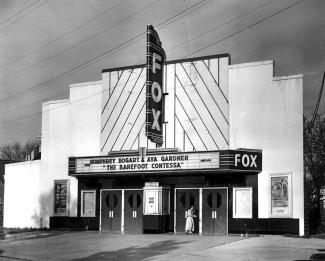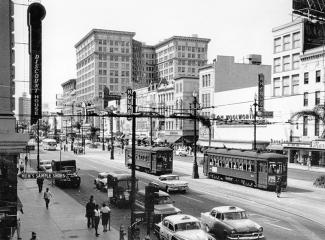My interest in Walker Percy’s novel, The Moviegoer, began, indirectly, on a road trip, which is appropriate, as The Moviegoer is, in a way, a road trip novel. I had travelled to the town of Monroeville, Alabama, in pursuit of some elusive truth about Harper Lee, the famous one-hit wonder, until, late in life, she published a second novel that upended all the assumptions, already fragile, about To Kill a Mockingbird, under circumstances that seemed suspicious. Esquire magazine sent me to see what there was to see and write about it. But beneath this broad mandate there was an unstated directive to get to the bottom of the convoluted story about how Go Set a Watchman was published, and in order to do that I had to talk to the person at the story’s center — Tonja Carter. And so I went to Monroeville to see the town’s amateur production of To Kill a Mockingbird, in the spring of 2016. Afterwards Ms. Carter, who declined to be interviewed, saw me peering through the window of the restaurant on the town square where the cast party was taking place, and waved me in.
I sat in the back at the bar, looking around, and at one point asked the person next to me if he had any idea where the line dividing the Eastern Time Zone from the Central Time Zone lay in relation to the town. He did not, but summoned a nearby waiter, a fresh-faced young man dressed in black pants, a black shirt, and a red bow tie, like all the waiters. He didn’t know, either. But he sat beside me trying to puzzle it out. Somehow, we began to talk about books. This was appropriate, because there may be no other town in America more devoted to a single book than Monroeville is devoted to To Kill a Mockingbird — murals of mockingbirds are painted onto the sides of buildings, a Mockingbird-themed museum and gift shop are located in the town square, and every spring a play based on the book has a two-week run in the very courthouse that was the book’s inspiration.
The aura of theft and malfeasance has hovered over Harper Lee for a long time, and not just because her one book is about crime and punishment. Alice Lee, Harper’s older sister — a surrogate mother in youth, a surrogate father in their adulthood and old age — had joined and then took over their father’s law practice. She remarked to a BBC researcher in 1982 that the manuscript for her sister’s second novel was stolen by a burglar. Whether or not this remark was facetious at the time, it would prove to be prophetic.
At the time of my arrival in May 2016, the town was adjusting itself in the aftermath of Harper Lee’s death that February. A few years earlier, a new Harper Lee novel had been found. The person who found it, Tonja Carter, did not have a consistent story about how and when she found it. But she was the estate’s executor. She had persuaded Harper Lee that it was a good idea to publish the manuscript, Go Set a Watchman. This was news in itself. When it was revealed that the book featured the same characters that appeared in her first, Atticus Finch in particular, it caused an uproar. The uproar became considerably louder when it became apparent that the Atticus Finch of that second novel was a much different character than the calm, paternal, attentive and just man that inspired love in so many people. If I wasn’t among the cult of Atticus, it wasn’t out of any considered dissent; I read the book in eighth grade, liked it OK, but I grew up in New York City.
The courthouse where the play is staged is the courthouse that Harper Lee used to visit as a child, where she would sometimes watch her father argue a case. Just down the street from the restaurant where I sat at the bar was a bank, and on the second floor of the bank was her father’s law office, the same one taken over by her older sister Alice, who practiced until she was 100 years old and lived until she was 103. Downstairs from the law office, in the bank vault, is where Tonja Carter found the manuscript for Go Set a Watchman in 2011 or 2014, depending on who you believe.
Which is why I was sitting at the back of the restaurant chatting with a young man in a black shirt with a red bow tie talking about literature. He was a Flannery O’Connor fan, he told me. The story that interested him most was called “Parker’s Back.” A fiercely religious woman dominates that story. The male character, her husband, seems to cower in front of her. Later, pondering Tonja Carter from a distance, this would seem significant.
I asked him how he came to his Flannery O’Connor enthusiasm, and he told me that he had a wonderful literature professor at the seminary he attended. It turned out he had recently graduated and was now in an interim period where he was debating whether to pursue his studies and become a priest or do something else.
“Where was the seminary?” I asked.
“Covington, Louisiana,” he said.
“What was the professor’s name?”
“Sister Jeanne d’Arc.”
2.
There’s a sort of perfection in the enclosed world of Depression-era Monroeville seen from the viewpoint of a young girl, Scout. It’s part of what makes To Kill a Mockingbird so enchanting, the world untouched by outside forces, the world unto itself with its own villains and heroes.
Lee’s novel came out in 1960. Another Southern story was published a year later, The Moviegoer by Walker Percy. The setting is New Orleans, a metropolis and a highly permeable world, but also enclosed, a small town, especially the world of Uptown, from which the book’s main character, Binx Bolling, has escaped. He lives in the magically bland suburb of Gentilly. Uptown is the mother ship. The newly developed suburbs of Gentilly and Lakeview are a fresh new landscape of anonymity and possibility.


































































